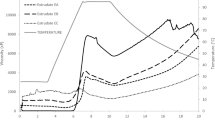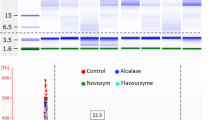Abstract
An enzymatic process was developed to produce protein hydrolysate from defatted soya protein. Various unit operations were tried, and the effects of pre- and post-treatments on the product characteristics such as degree of hydrolysis (DH), free amino acid content (%FAA) and average molecular weight (MW) were investigated. The use of acid washes showed no difference in %DH. Increasing pH during pre-cooking gave lower %DH. Alkaline cooking made too much insoluble protein, thus the protein yield was too small. A better hydrolysis with more acceptable taste was obtained when the combination of Neutrase/Alcalase/Flavourzyme was used in place of Alcalase/Flavourzyme combination. Untoasted defatted soya was more effective on the proteolysis than toasted one. The MW of the evaporated and spray dried product was higher than that of undried product, due to precipitation of low-solubility components. When the product separation was carried out by ultrafiltration and the product concentration by reverse osmosis, the solubility and the taste of the product were improved. The difference between enzyme hydrolysate and acid hydrolysate was significant in free amino acid composition, especially in tyrosine, phenylalanine, glutamine and asparagine.
Similar content being viewed by others
References
Lahl, W. J. and S. D. Braun (1994) Enzymatic production of protein hydrolysates for food use.Food Technol. 48:68–71.
Frokjaer, B. (1994) Use of hydrolysates for protein supplementation.Food Technol. 48:86–88.
Schmidl, M. K., S. L. Taylor, and J. A. Nordlee (1994) Use of hydrolysate-based products in special medical diets.Food Technol. 48:77–85.
Mahmoud, M. I., W. T. Malone, and C. T. Cordle (1992) Enzymatic hydrolysis of casein: effect of degree of hydrolysis on antigenicity and physical properties.J. Food Sci. 57:1223–1229.
Herbert, A. B. and P. Dunnill (1988) Limited modifications of soya proteins by immobilized subtilisin: comparison of products from different reactor types.Biotechnol. Bioeng. 32:475–481.
Ericsson, R. J. and G. A. Youngdale (1970) Male antifertility compounds: structure and activity relationships of U-5897, U-15,646 and related substances.J. Reprod. Fert. 21:263–266.
IHPC board (1995) Position paper on 3-monochloropropanediol (3-MCPD). IHPC Report 3-6-95. Washington.
Pommer, K. (1995) New proteolytic enzymes for the production of savory ingredients.Cereal Foods World 40:745–748.
Olsen, H. S. and J. Adler-Nissen (1979) Industrial production and applications of a soluble enzymatic hydrolyzate of soya protein.Process Biochem. 14:6–11.
Quaglia, G. B. and E. Orban (1987) Influence of the degree of hydrolysis on the solubility of the protein hydrolysates from sardine (sardine pilchardus).J. Sci. Food Agric. 38:271–276.
Adler-Nissen, J. (1986) ISSPH-the production and properties of an enzymic food protein hydrolysate. p. 263–313 In: J. Adler-Nissen (ed.)Enzymatic Hydrolysis of Food Proteins. Elsevier Applied Science Publisher. New York.
Adler-Nissen, J. (1979) Determination of the degree of hydrolysis of food protein hydrolyzates by trinitrobenzenesulfonic acid.J. Agric. Food Chem. 27:1256–1262.
Richter, W. O., B. Jacob, and P. Schwandt (1983) Molecular weight determination of peptides by high-performance gel permeation chromatography.Anal. Biochem. 133:288–291.
Waters Associate, (1990) p. 24–32 In:Waters amino acid analysis system. Youngin Scientific Co., Ltd. Seoul.
Hjalmarsson, S. and R. Akesson (1983) Modern Kjeldahl procedure.Int. Laboratory. 3: 70–76.
Howell, N. K. (1996) Chemical and enzymatic modifications. p. 262–263 In: S. Nakai and H. W. Modler (ed.)Food Proteins: Properties and Characterization. VCH Publishers, Inc. New York.
Chae, H. J., M.-J. In, and M.-H. Kim (1997) Optimization of enzyme treatment for the enzymatic production of hydrolyzed vegetable protein.Kor. J. Food Sci. Technol. 29:1125–1130.
Chae, H. J., M.-J. In, and J. D. Lee (1998) Production of a flavoring material from soymilk residues by combined use of enzymes and microorganisms.Agric. Chem. Biotechnol. 41:73–77.
Friedman, M., D. L. Brandon, A. H. Bates, and T. Hymowitz (1991) Comparison of commercial soybean cultivar and an isoline lacking the Kunitz trypsin inhibitor: composition, nutritional value, and effect of heating.J. Agric. Food Chem. 39:327–335.
Bigelow, C. C. (1967) On the average hydrophobicity of proteins and the relation between it and protein structure.J. Theor. Biol. 16:187–211.
Author information
Authors and Affiliations
Corresponding author
Rights and permissions
About this article
Cite this article
Chae, H.J., In, MJ. & Kim, MH. Process development for the enzymatic hydrolysis of food protein: Effects of pre-treatment and post-treatments on degree of hydrolysis and other product characteristics. Biotechnol. Bioprocess Eng. 3, 35–39 (1998). https://doi.org/10.1007/BF02932481
Issue Date:
DOI: https://doi.org/10.1007/BF02932481




